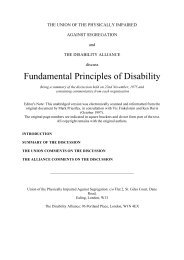Global-Report-Living-Colour-dr2-2
Global-Report-Living-Colour-dr2-2
Global-Report-Living-Colour-dr2-2
You also want an ePaper? Increase the reach of your titles
YUMPU automatically turns print PDFs into web optimized ePapers that Google loves.
86<br />
Inclusive Communities = Stronger Communities<br />
GLOBAL REPORT ON ARTICLE 19: THE RIGHT TO LIVE AND BE INCLUDED IN THE COMMUNITY<br />
had previously relied on institutions as a residential<br />
option, closing or in the process of closing<br />
institutional facilities, there are other countries that<br />
are in the process of building (new) institutions<br />
and/or refurbishing existing facilities e.g. In Hungary,<br />
“Despite having a 30-year strategy to shut institutions<br />
and move people with disabilities into the<br />
community, the Hungarian government will build<br />
new 50-bed institutions – which it euphemistically<br />
calls “living centres” – instead of integrating and<br />
supporting people into the community.” 7<br />
Even in those countries that have a history of<br />
successful closures (i.e. Canada, the USA, the<br />
UK) we are seeing continued investment in<br />
institutional models of support.<br />
There are also countries, particularly low<br />
income countries in Africa, in which the<br />
traditional concept of institutions does not<br />
exist. In these countries however, institutions<br />
do not exist not because other more<br />
appropriate options are provided, but rather<br />
because families were (and are still being)<br />
left to struggle on their own to raise and<br />
support their family member with little or no<br />
outside support or assistance. Sometimes families<br />
who are desperate for any kind of support will<br />
suggest the creation of institutions because they<br />
cannot imagine any other options.<br />
In Colombia families face a stark choice. They can<br />
give up custody of their son or daughter and in<br />
exchange a bed in a residential institution with three<br />
meals a day and some daytime activities will be<br />
provided. The one residential institution we visited in<br />
Bogota was stark, with little activity and no real<br />
personalization or sense of personal space or privacy.<br />
Should the family not want the institutional option,<br />
there are few services for children and virtually none<br />
for adults unless the family has the financial resources



